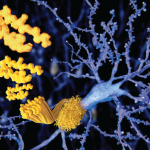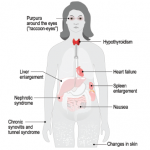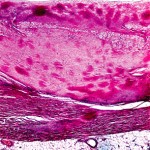ATTRwt (amyloid from wild type or natural, without mutation of, TTR)—ATTRwt is the most common, but under-recognized form of amyloid, commonly causing new onset of congestive heart failure (CHF) in men older than 75. It’s estimated that 25–30% of the normal population has amyloid cardiac deposition. Of interest from the rheumatology point of view, approximately 50% of ATTRwt patients will have carpal tunnel syndrome (CTS) symptoms 5–10 years before the onset of CHF, so we recommend thinking about ATTRwt when a rheumatologist sees an older male with new onset of CTS.
ALect2 (amyloid from leucocyte chemotactic factor 2)—Researchers discovered leucocyte chemotactic factor 2 (ALect2) amyloidosis in 2008. It is found in individuals of Mexican/Hispanic heritage, and in the U.S. it is thus most frequently diagnosed in New Mexico, Arizona and West Texas. It can also be found in Egypt, Punjab and the First Nations people of Canada. It is diagnosed between the ages of 43 and 88 years, and patients present with slowly progressive renal failure, which, after approximately five years, leads to end-stage renal disease. These patients typically do not have proteinuria.
Diagnosing Amyloidosis
In many cases, patients with amyloidosis have a normal result on serum protein electrophoresis (SPEP) test, so this test is not particularly useful for diagnosis. In addition to serum and urine immunofixation, the most sensitive test is the free light chain assay, and Dr. Libbey recommends these tests for diagnosis when looking for plasma cell dyscrasia associated with AL amyloid.
Patients with cardiac involvement may have an electrocardiogram that reveals arrhythmia and low voltage, and shows thickened septal measurements. These patients could be imaged with a cardiac MRI with late gadolinium enhancement, as well as a technetium TC 99M pyrophosphate Tc99-pyrophosphate scan. This scan may distinguish AL from ATTR cardiomyopathy.
If a physician diagnoses amyloidosis with cardiac involvement, the patient should not be prescribed digoxin or calcium channel blockers; these medications bind to fibril and potentiate toxicity. Likewise, if a patient with mild congestive heart failure is responding poorly to these drugs, it may be because of the presence of amyloid in the heart.
The only way to make a diagnosis of amyloid is with a tissue biopsy. It is recommended to start with an abdominal fat cell aspirate, which can be done at the bedside.
Dr. Libbey concluded her presentation by explaining that effective treatments are now available for most kinds of amyloid, if it is diagnosed early in the course of the disease. AL can be treated with autologous stem cell transplant or chemotherapy aimed at the plasma cell dyscrasia. AA can be treated with aggressive management of the underlying disease, ATTR can be slowed by a TTR stabilizer, such as diflunisal or tafamidis in Europe, or patients may be considered for liver transplant. A variety of novel treatments are being studied, which will change the future of this not-so-rare disease.


